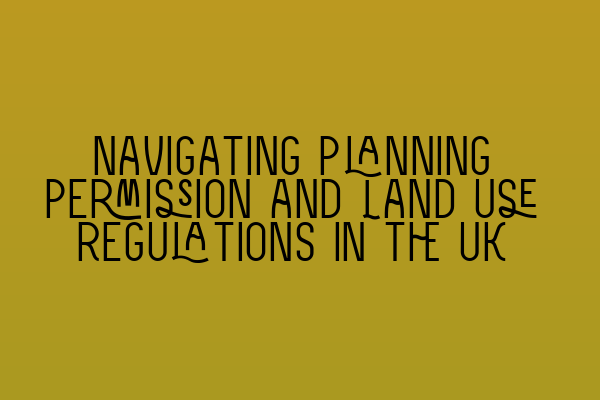Navigating Planning Permission and Land Use Regulations in the UK
As solicitors specializing in property law and land law, we understand that navigating the complexities of planning permission and land use regulations can be a daunting task. Whether you are a property developer, homeowner, or landowner, understanding the legal requirements and processes involved is crucial to ensure compliance and the successful progression of your project.
In this blog post, we will provide you with an overview of planning permission and land use regulations in the UK. We will discuss the importance of planning permission, the different types of applications available, and the key factors to consider when applying. So, let’s dive in!
The Importance of Planning Permission
Planning permission is the legal consent required from the local planning authority before any building work or change in land use can take place. It is designed to control and manage the development of land to ensure it is done in a sustainable and appropriate manner.
Obtaining planning permission is essential as without it, your proposed development may be considered unlawful, and the local planning authority has the power to enforce action, including the demolition of any unauthorized structures or cessation of activities.
Now, let’s discuss the different types of planning permission applications available:
Full Planning Permission
Full planning permission is the most common type of application and is required for all significant developments and major changes in land use. It involves submitting a detailed application to the local planning authority, including detailed plans, supporting documents, and a fee.
During the assessment process, the local planning authority will consider various factors, including the impact on the local environment, infrastructure, and community. They will also assess whether the proposed development aligns with the local development plan and any applicable national policies.
If granted, full planning permission provides the legal consent required to proceed with the development. It is essential to comply with any conditions attached to the planning permission and any subsequent building regulations.
Outline Planning Permission
Outline planning permission is a less detailed form of application that provides an initial indication of whether the local planning authority is prepared to grant planning permission for a particular development or change in land use.
When submitting an outline planning permission application, you will need to provide basic information regarding your proposal, such as the type of development, its approximate location, and any supporting documents. The level of detail required may vary depending on the local planning authority.
If an outline planning permission application is approved, it establishes the fundamental principles of development, such as the number of units, access points, and land use. However, it is necessary to submit a subsequent “reserved matters” application to address the detailed design and other specific details before commencing the development.
Key Factors to Consider
When applying for planning permission, there are several important factors you should consider:
Local Development Plan
The local development plan is a document prepared by the local planning authority that outlines their vision and policies for the development and use of land in their area. It provides guidance on what types of developments are likely to be permitted and in what locations.
Familiarize yourself with the local development plan before submitting a planning permission application to understand any relevant policies or restrictions that may apply.
Design and Layout
The design and layout of your proposed development play a crucial role in determining whether planning permission will be granted. The local planning authority will consider factors such as the impact on the local environment, the character of the area, and any potential harm to neighboring properties.
Ensure that your plans are well-prepared, include detailed drawings, and consider any design guidelines or policies specified by the local planning authority.
Community Engagement
Engaging with the local community and addressing any concerns they may have regarding your proposed development can significantly impact the outcome of your planning permission application.
Consider holding a public consultation to gather feedback and make any necessary adjustments to your plans. This will demonstrate that you have considered the views of the community and have taken steps to mitigate any potential issues.
Professional Advice
Given the complexity of planning permission and land use regulations, seeking professional advice is highly recommended. Property law solicitors with expertise in planning permission can provide valuable guidance throughout the process, ensuring compliance with the law and maximizing the chances of a successful outcome.
If you require assistance with planning permission or land use regulations, SQE Property Law & Land Law specializes in providing expert legal advice and representation. Contact our team today to discuss your requirements.
In conclusion, navigating planning permission and land use regulations in the UK requires a comprehensive understanding of the legal requirements and processes involved. It is crucial to choose the appropriate type of planning application, comply with local development plans and policies, and consider factors such as design, community engagement, and seeking professional advice.
Remember, SQE Property Law & Land Law is here to assist you every step of the way. For further guidance and expert legal support, don’t hesitate to get in touch with our team.
